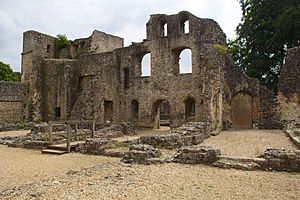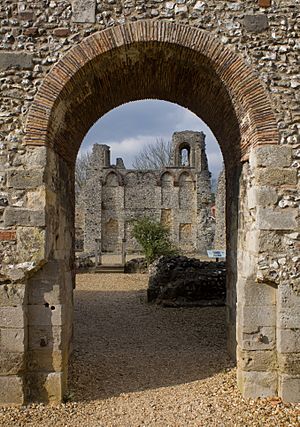Wolvesey Castle facts for kids
Quick facts for kids Wolvesey Castle |
|
|---|---|
 |
|
| Type | Bishop's palace, briefly fortified as a castle |
| Location | Winchester |
| OS grid reference | SU 48459 29088 |
| Area | Hampshire |
| Owner | English Heritage |
| Official name: Wolvesey Palace | |
| Designated | 19 April 1915 |
| Reference no. | 1005535 |
|
Listed Building – Grade I
|
|
| Official name: Wolvesey Castle | |
| Designated | 24 March 1950 |
| Reference no. | 1095511 |
| Lua error in Module:Location_map at line 420: attempt to index field 'wikibase' (a nil value). | |
Wolvesey Castle, also known as the "Old Bishop's Palace", is a cool ruined building in Winchester, Hampshire, England. It used to be a fancy home for the Bishop of Winchester. For a short time, it was even made stronger like a castle!
The very first building here was put up around 970. It was built by Æthelwold of Winchester, who was the Bishop of Winchester back then. This first palace was on a small island in the River Itchen. People called this island Wulveseye, which means Wulf's island.
Later, in 1141, Winchester faced a big attack during a civil war called The Anarchy. The Empress Matilda tried to take over the city. Wolvesey Castle held out for three weeks! It was finally saved by Stephen's wife, Matilda.
After this, Henry of Blois, who was the Bishop and also King Stephen's brother, made the palace much stronger. He added thick walls around it, making it look like a real castle. But after Henry died in 1171, King Henry II ordered some of these defenses to be taken down.
Wolvesey Castle was a very important place. In 1554, Queen Mary and Philip II of Spain had their wedding party here! Sadly, the castle was destroyed in 1646 by the Roundheads during the English Civil War.
Today, the ruins are next to the bishop's current home. English Heritage looks after them.
The Bishop's Palace
The first palace at Wolvesey was built around 970. It was created by Æthelwold of Winchester. He chose a spot on a small island in the River Itchen. This island was called Wulveseye.
Around 1110, a new part was added by William Giffard, another bishop. His follower, Henry of Blois, built a second large hall between 1135 and 1138. These halls were important parts of the palace.
A newer palace was built nearby in 1684. It was in a grand style called baroque. However, much of this new palace was later taken down in 1786. The remaining part was fixed up in 1926. It is now used again as the bishop's home.
How the Palace Became a Castle
Wolvesey Palace was the scene of a big battle in 1141. This was during a civil war known as The Anarchy. The Empress Matilda and Bishop Henry fought for control of Winchester.
During the fight, the people defending Wolvesey set fire to many houses in the city. Most of old Winchester was destroyed. Empress Matilda's forces tried to take the palace for three weeks. But then, King Stephen's wife, Matilda, arrived with more soldiers.
After this tough battle, Bishop Henry made the palace much stronger. He connected the two large halls with a thick curtain wall. This made the palace look like a strong castle.
However, after Bishop Henry died in 1171, King Henry II ordered some changes. He had parts of the castle's defenses removed. This meant things like the main gate and the heavy portcullis (a strong gate that drops down) were probably taken away. But the living areas were not destroyed. Many bishops continued to live there in style.
Wolvesey was a very important place for royal events. On July 25, 1554, Queen Mary and Philip II of Spain had their wedding party there. It was a huge celebration!
Sadly, the palace was destroyed in 1646. This happened during the English Civil War. Soldiers called Roundheads caused the damage.
Today, only the chapel of the palace is still mostly standing. It is still used and is connected to the bishop's current home.
Visiting Wolvesey Castle Today
The amazing ruins of Wolvesey Castle are looked after by English Heritage. They are a special historic site. The ruins have been protected since 1950. This means they are a "Grade I listed" building.
You can still see a lot of the strong curtain wall. Most of the inside rooms are gone now. But you can still imagine where the main hall was. There is a beautiful round arch and one old Norman window that you can see.


